英语Coffee介绍
- 格式:ppt
- 大小:2.79 MB
- 文档页数:3
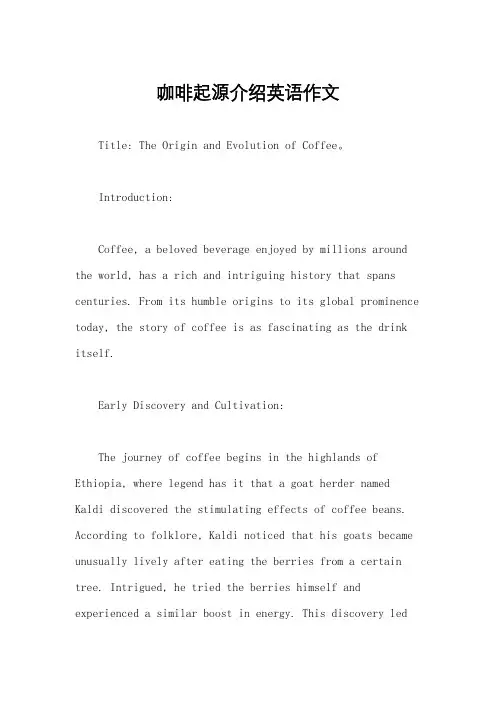
咖啡起源介绍英语作文Title: The Origin and Evolution of Coffee。
Introduction:Coffee, a beloved beverage enjoyed by millions around the world, has a rich and intriguing history that spans centuries. From its humble origins to its global prominence today, the story of coffee is as fascinating as the drink itself.Early Discovery and Cultivation:The journey of coffee begins in the highlands of Ethiopia, where legend has it that a goat herder named Kaldi discovered the stimulating effects of coffee beans. According to folklore, Kaldi noticed that his goats became unusually lively after eating the berries from a certain tree. Intrigued, he tried the berries himself and experienced a similar boost in energy. This discovery ledto the cultivation of coffee plants in the region, eventually spreading to neighboring regions such as Yemen.Spread to the Arab World:Coffee cultivation and consumption became deeply intertwined with Arab culture during the 15th century. The Arabs were the first to cultivate coffee on plantations, and they also developed methods for roasting and brewing the beans to perfection. Coffee houses, known as qahveh khaneh, began to emerge in cities like Mecca and Constantinople, serving as social hubs where people gathered to drink coffee, engage in conversation, and even listen to music or poetry.Introduction to Europe:The popularity of coffee soon spread beyond the Arab world, reaching Europe in the 17th century. The first coffeehouse in Europe opened in Venice in 1645, quickly followed by establishments in other major cities like London, Paris, and Vienna. Coffeehouses became centers ofintellectual exchange, attracting scholars, artists, and thinkers who engaged in lively discussions and debates. The beverage itself gained a reputation for its stimulating effects on the mind, leading some to hail it as the "drink of the mind" or the "intellectual beverage."Colonial Expansion:The spread of coffee cultivation was closely tied to European colonialism, particularly in regions with suitable climates such as the Caribbean, Central and South America, and Southeast Asia. European powers established coffee plantations in colonies like Brazil, Colombia, and Java, fueling the global demand for coffee beans. The labor-intensive nature of coffee cultivation also contributed to the rise of the transatlantic slave trade, as enslaved Africans were forcibly brought to work on coffee plantations.Industrialization and Modernization:The industrial revolution of the 19th centurytransformed the production and consumption of coffee on a global scale. Innovations such as the coffee roaster, grinder, and espresso machine revolutionized the way coffee was prepared and served. Mass production techniques and improved transportation networks further fueled the expansion of the coffee industry, making coffee readily available to people around the world.Cultural Significance:Throughout its history, coffee has played a significant role in shaping cultures and societies. From thetraditional coffee ceremonies of Ethiopia to the espresso culture of Italy, coffee rituals vary widely across different regions and communities. Coffee has also inspired works of art, literature, and music, becoming a symbol of creativity and social interaction.Conclusion:In conclusion, the history of coffee is a testament to its enduring popularity and cultural significance. From itshumble beginnings in Ethiopia to its global presence today, coffee has evolved into much more than just a beverage—it is a symbol of socialization, creativity, and shared experiences. As we continue to enjoy our daily cup of coffee, let us appreciate the rich history and cultural heritage behind this beloved drink.。
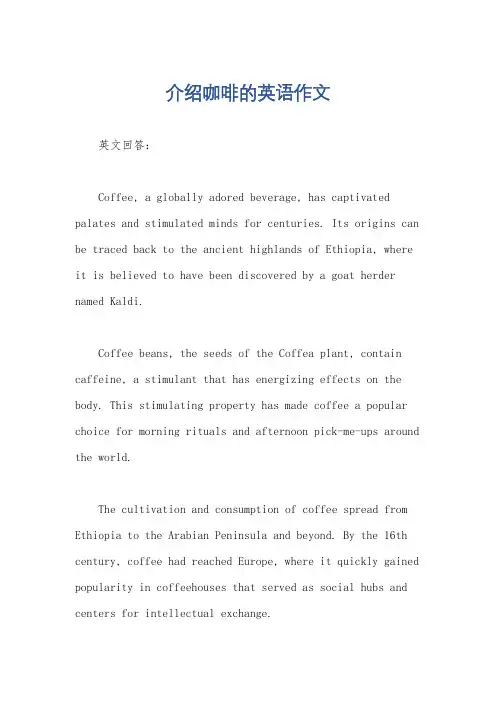
介绍咖啡的英语作文英文回答:Coffee, a globally adored beverage, has captivated palates and stimulated minds for centuries. Its origins can be traced back to the ancient highlands of Ethiopia, where it is believed to have been discovered by a goat herder named Kaldi.Coffee beans, the seeds of the Coffea plant, contain caffeine, a stimulant that has energizing effects on the body. This stimulating property has made coffee a popular choice for morning rituals and afternoon pick-me-ups around the world.The cultivation and consumption of coffee spread from Ethiopia to the Arabian Peninsula and beyond. By the 16th century, coffee had reached Europe, where it quickly gained popularity in coffeehouses that served as social hubs and centers for intellectual exchange.There are various types of coffee beans, with the two main varieties being Arabica and Robusta. Arabica beans are generally considered to have a smoother, more balanced flavor, while Robusta beans have a higher caffeine content and a more intense, bitter taste.The roasting process plays a crucial role in determining the flavor and aroma of coffee. Different roasting levels, from light to dark, produce varying degrees of bitterness, acidity, and body.Coffee can be brewed using various methods, each imparting its own distinct character to the beverage. Drip coffee, made by passing hot water through ground coffee, is a common brewing method that produces a balanced and straightforward cup. French press, which involves steeping coffee grounds in hot water and then pressing them down, yields a full-bodied and rich brew. Espresso, a concentrated coffee shot brewed under high pressure, forms the base for many other coffee drinks such as cappuccinos and lattes.Coffee is a versatile beverage that can be enjoyed in countless ways. It can be consumed black, with milk and sugar, or flavored with spices, syrups, and liqueurs.Coffee can also be used as an ingredient in baking, desserts, and savory dishes.中文回答:咖啡,一种全球备受追捧的饮品,几个世纪以来一直吸引着味蕾,刺激着大脑。
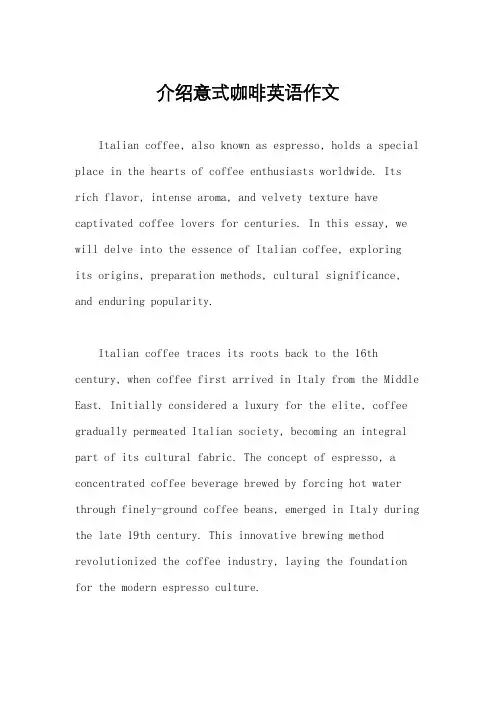
介绍意式咖啡英语作文Italian coffee, also known as espresso, holds a special place in the hearts of coffee enthusiasts worldwide. Its rich flavor, intense aroma, and velvety texture have captivated coffee lovers for centuries. In this essay, we will delve into the essence of Italian coffee, exploringits origins, preparation methods, cultural significance, and enduring popularity.Italian coffee traces its roots back to the 16th century, when coffee first arrived in Italy from the Middle East. Initially considered a luxury for the elite, coffee gradually permeated Italian society, becoming an integral part of its cultural fabric. The concept of espresso, a concentrated coffee beverage brewed by forcing hot water through finely-ground coffee beans, emerged in Italy during the late 19th century. This innovative brewing method revolutionized the coffee industry, laying the foundation for the modern espresso culture.Central to the Italian coffee experience is the espresso bar, a cornerstone of Italian social life. These bustling establishments serve as communal hubs where people gather to savor their favorite brew, engage in lively conversation, and soak in the vibrant atmosphere. The espresso bar embodies the Italian philosophy of "sprezzatura," a sense of effortless elegance and nonchalance that permeates every aspect of daily life.The preparation of Italian coffee is an art form in itself, requiring precision, skill, and a deep understanding of the brewing process. The key to a perfect espresso lies in the quality of the beans, the grind size, water temperature, and brewing time. Baristas meticulously calibrate these variables to extract the full spectrum of flavors locked within the coffee grounds, resulting in a sensory experience like no other.One of the defining characteristics of Italian coffee is its intense flavor profile. Unlike drip coffee, which is brewed slowly over a prolonged period, espresso is prepared quickly, resulting in a concentrated shot of caffeine-infused goodness. The hallmark of a well-crafted espresso is its "crema," a golden-brown layer of froth that crowns the surface, signaling freshness and quality.In addition to espresso, Italy boasts a diverse array of coffee beverages, each with its own unique flavorprofile and preparation method. Cappuccino, a beloved classic, combines espresso with steamed milk and a dollop of froth, creating a creamy and indulgent treat. Macchiato, on the other hand, features a shot of espresso "stained" with a small amount of milk, striking a perfect balance between bitterness and sweetness.Beyond its culinary appeal, Italian coffee serves as a cultural touchstone, embodying the essence of Italian identity and tradition. It reflects Italy's passion for craftsmanship, its devotion to quality, and its celebration of life's simple pleasures. Whether enjoyed solo at a bustling espresso bar or shared with friends over lively conversation, Italian coffee fosters a sense of connection and camaraderie that transcends language and borders.In conclusion, Italian coffee occupies a hallowed place in the pantheon of global gastronomy, revered for its unparalleled flavor, aroma, and cultural significance. From its humble origins in the cafes of 16th-century Italy toits status as a beloved beverage enjoyed by millions worldwide, espresso continues to enchant and inspire coffee aficionados everywhere. So, the next time you savor a velvety shot of Italian espresso, take a moment to appreciate the centuries of tradition and craftsmanshipthat have gone into e very cup. Buon caffè!。
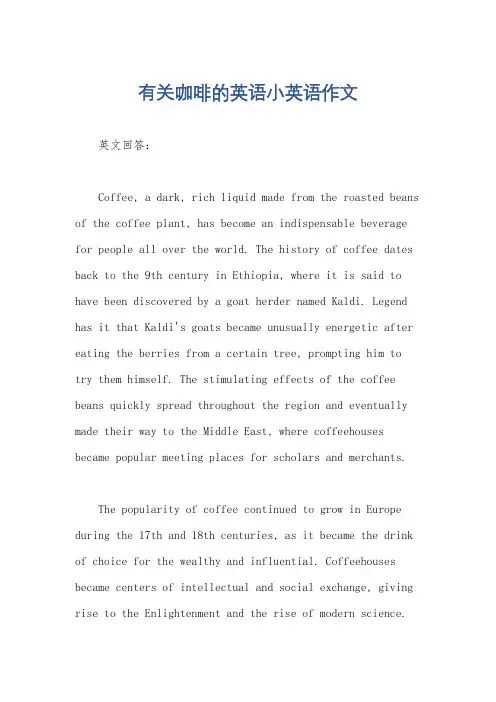
有关咖啡的英语小英语作文英文回答:Coffee, a dark, rich liquid made from the roasted beans of the coffee plant, has become an indispensable beverage for people all over the world. The history of coffee dates back to the 9th century in Ethiopia, where it is said to have been discovered by a goat herder named Kaldi. Legend has it that Kaldi's goats became unusually energetic after eating the berries from a certain tree, prompting him totry them himself. The stimulating effects of the coffee beans quickly spread throughout the region and eventually made their way to the Middle East, where coffeehouses became popular meeting places for scholars and merchants.The popularity of coffee continued to grow in Europe during the 17th and 18th centuries, as it became the drink of choice for the wealthy and influential. Coffeehouses became centers of intellectual and social exchange, giving rise to the Enlightenment and the rise of modern science.However, coffee also faced opposition from religious authorities who deemed it to be a dangerous stimulant.Despite these challenges, the popularity of coffee continued to grow and it eventually became a staple beverage in homes and businesses around the world. Today, coffee is one of the most widely consumed beverages in the world, with over 2.25 billion cups consumed each day.Coffee is a complex beverage with a wide range of flavors and aromas, depending on the type of beans used, the roasting process, and the brewing method. The most common types of coffee beans are Arabica and Robusta, with Arabica being known for its smooth, nuanced flavors and Robusta for its bolder, more bitter taste. Coffee can be roasted to varying degrees, from light to dark, with each level of roasting producing a different flavor profile. The brewing method also affects the taste of coffee, with different methods producing different levels of acidity, bitterness, and body.The health effects of coffee have been the subject ofmuch debate over the years. Some studies have linked coffee consumption to a reduced risk of certain types of cancer, cardiovascular disease, and type 2 diabetes. However, other studies have suggested that excessive coffee consumption may be associated with increased anxiety, insomnia, and digestive problems. Overall, the evidence suggests that moderate coffee consumption (up to 4 cups per day) is generally safe and may even have some health benefits.In conclusion, coffee is a beloved beverage with a rich history and a complex flavor profile. Its popularity has endured for centuries, and it continues to be enjoyed by people from all walks of life.中文回答:咖啡,一种由咖啡树烘焙过的豆子制成的深色浓郁液体,已成为全世界人们不可或缺的饮料。
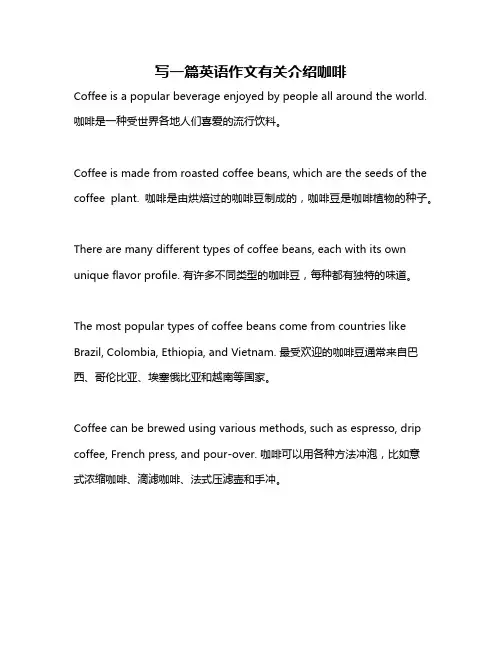
写一篇英语作文有关介绍咖啡Coffee is a popular beverage enjoyed by people all around the world. 咖啡是一种受世界各地人们喜爱的流行饮料。
Coffee is made from roasted coffee beans, which are the seeds of the coffee plant. 咖啡是由烘焙过的咖啡豆制成的,咖啡豆是咖啡植物的种子。
There are many different types of coffee beans, each with its own unique flavor profile. 有许多不同类型的咖啡豆,每种都有独特的味道。
The most popular types of coffee beans come from countries like Brazil, Colombia, Ethiopia, and Vietnam. 最受欢迎的咖啡豆通常来自巴西、哥伦比亚、埃塞俄比亚和越南等国家。
Coffee can be brewed using various methods, such as espresso, drip coffee, French press, and pour-over. 咖啡可以用各种方法冲泡,比如意式浓缩咖啡、滴滤咖啡、法式压滤壶和手冲。
Each brewing method produces a unique taste and aroma, catering to different preferences of coffee drinkers. 每种冲泡方法都能产生独特的口味和香气,迎合不同咖啡爱好者的口味。
For many people, coffee is not just a beverage, but an essential part of their daily routine. 对许多人来说,咖啡不仅仅是一种饮料,而且是他们日常生活不可或缺的一部分。
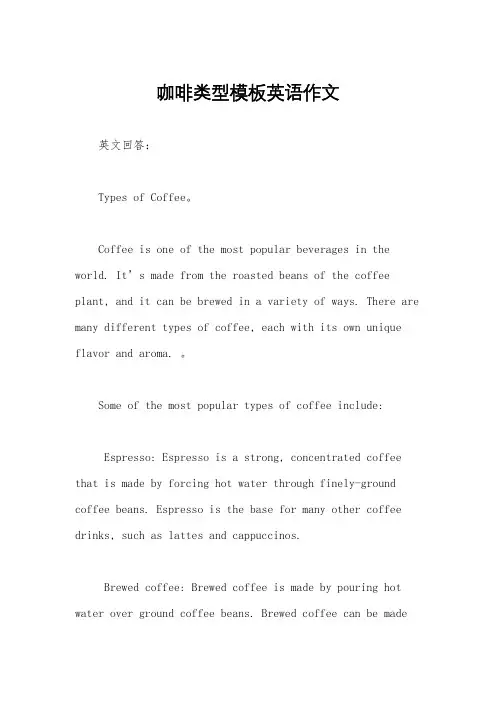
咖啡类型模板英语作文英文回答:Types of Coffee。
Coffee is one of the most popular beverages in the world. It’s made from the roasted beans of the coffee plant, and it can be brewed in a variety of ways. There are many different types of coffee, each with its own unique flavor and aroma. 。
Some of the most popular types of coffee include:Espresso: Espresso is a strong, concentrated coffee that is made by forcing hot water through finely-ground coffee beans. Espresso is the base for many other coffee drinks, such as lattes and cappuccinos.Brewed coffee: Brewed coffee is made by pouring hot water over ground coffee beans. Brewed coffee can be madein a variety of ways, including using a drip coffee maker, a French press, or a pour-over cone.Cold brew coffee: Cold brew coffee is made by steeping ground coffee beans in cold water for 12-24 hours. Cold brew coffee is less acidic and bitter than brewed coffee, and it has a smoother, sweeter flavor.Instant coffee: Instant coffee is made from dried coffee extract. Instant coffee is quick and easy to make, but it does not have the same flavor or aroma as brewed coffee.The type of coffee you choose will depend on your personal preferences. If you like strong, concentrated coffee, then espresso is a good choice. If you prefer a milder, smoother coffee, then brewed coffee or cold brew coffee may be a better option. Instant coffee is a good choice for those who want a quick and easy cup of coffee.Coffee Brewing Methods。
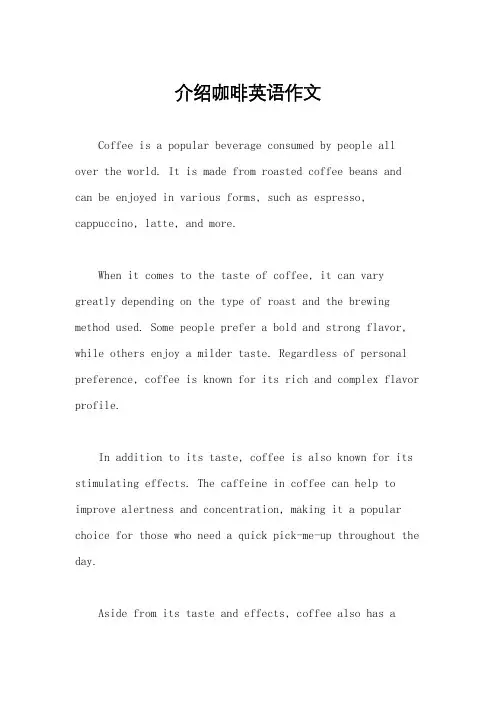
介绍咖啡英语作文Coffee is a popular beverage consumed by people all over the world. It is made from roasted coffee beans and can be enjoyed in various forms, such as espresso, cappuccino, latte, and more.When it comes to the taste of coffee, it can vary greatly depending on the type of roast and the brewing method used. Some people prefer a bold and strong flavor, while others enjoy a milder taste. Regardless of personal preference, coffee is known for its rich and complex flavor profile.In addition to its taste, coffee is also known for its stimulating effects. The caffeine in coffee can help to improve alertness and concentration, making it a popular choice for those who need a quick pick-me-up throughout the day.Aside from its taste and effects, coffee also has arich cultural history. It has been enjoyed for centuriesand is an integral part of many cultures around the world. From the traditional coffeehouses of Europe to the bustling cafes of America, coffee has played a significant role in shaping the social and cultural landscape of many societies.Overall, coffee is a beloved beverage that continues to be enjoyed by millions of people worldwide. Whether you prefer a strong espresso or a creamy latte, there is no denying the appeal and versatility of this popular drink.。
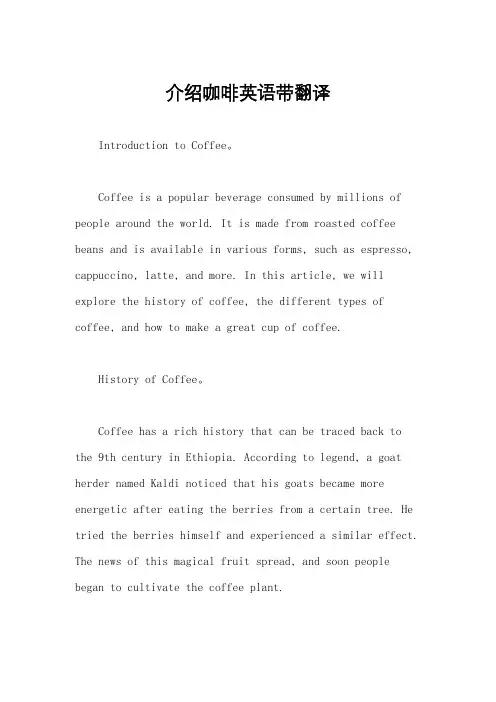
介绍咖啡英语带翻译Introduction to Coffee。
Coffee is a popular beverage consumed by millions of people around the world. It is made from roasted coffee beans and is available in various forms, such as espresso, cappuccino, latte, and more. In this article, we will explore the history of coffee, the different types of coffee, and how to make a great cup of coffee.History of Coffee。
Coffee has a rich history that can be traced back to the 9th century in Ethiopia. According to legend, a goat herder named Kaldi noticed that his goats became more energetic after eating the berries from a certain tree. He tried the berries himself and experienced a similar effect. The news of this magical fruit spread, and soon people began to cultivate the coffee plant.The first coffee shop opened in Istanbul, Turkey in the 15th century, and coffee soon became a popular drink in the Middle East. In the 17th century, coffee was introduced to Europe, and coffeehouses began to appear in cities like London and Paris. Today, coffee is enjoyed all over the world and is an integral part of many cultures.Types of Coffee。



咖啡英语作文模板带翻译Title: The Culture of Coffee。
Coffee is one of the most popular beverages in the world. It has a rich and diverse history, and it is deeply ingrained in the cultures of many countries. In this essay, we will explore the cultural significance of coffee and its impact on society.咖啡是世界上最受欢迎的饮料之一。
它有着丰富多样的历史,深深扎根于许多国家的文化中。
在这篇文章中,我们将探讨咖啡的文化意义以及它对社会的影响。
First and foremost, coffee plays a significant role in social interactions. In many cultures, the act of drinking coffee is a social ritual that brings people together. Whether it's meeting a friend for a cup of coffee or gathering with family members to enjoy a morning brew, coffee has the power to foster connections and strengthen relationships. In some countries, such as Italy and Turkey, coffee is an integral part of daily life, and it is often consumed in social settings such as cafes and coffee houses.首先,咖啡在社交互动中扮演着重要的角色。
咖啡的种类及口味英语介绍Coffee: A Journey Through Its Types and Flavors.Coffee, a brewed beverage prepared from roasted seeds, or commonly known as coffee beans, of the coffee plant, is one of the world's main beverages alongside cocoa and tea. Its history dates back to the 9th century when it was first discovered in the highlands of Ethiopia. Since then, coffee has gained popularity and has become an important export commodity for many countries.Types of Coffee.1. Arabica Coffee: This is the most widely grown and consumed coffee variety in the world. It is known for its smooth and mellow taste, with notes of fruitiness and acidity.2. Robusta Coffee: Another common coffee variety, Robusta is known for its strong and bitter taste. It has ahigher caffeine content compared to other varieties.3. Blue Mountain Coffee: This is a high-quality coffee from Jamaica, renowned for its rich and full-bodied flavor. It is often described as having a sweet, fruity, and chocolatey taste.4. Colombian Coffee: Colombian coffee is world-renowned for its balanced acidity, smooth taste, and rich aroma. It is often described as having a nutty and chocolaty flavor.5. Vietnamese Coffee: Vietnamese coffee is known forits strong and robust flavor. It is typically served with a layer of sweetened condensed milk on top, creating a unique and delicious contrast.Flavors of Coffee.Coffee flavors can vary depending on the type of bean, roasting method, and brewing technique. Here are some common flavors found in coffee:1. Fruitiness: This refers to the sweet and tartflavors reminiscent of fruits such as berries, apples, or cherries. This flavor is often found in lighter roasts.2. Acidity: Coffee acidity is not the same as sourness. It refers to the bright, snappy, and lively qualities in the cup. Acidity can range from soft and velvety to sharp and zingy.3. Nutty: This flavor is reminiscent of nuts such as hazelnuts, almonds, or peanuts. It is often found in medium-dark roasts.4. Chocolatey: This flavor refers to the rich, sweet, and sometimes bitter qualities reminiscent of chocolate. It is often found in darker roasts.5. Smoky: This flavor is typically found in coffee from regions where the beans are processed over an open fire. It adds a unique and complex quality to the cup.Coffee also has a range of secondary flavors that canenhance the overall experience. These include caramel, vanilla, toffee, spice, and even floral notes. The presence of these flavors depends on the coffee's origin, processing method, and roasting profile.In conclusion, coffee is a beverage that offers a diverse range of types and flavors. From its smooth and mellow Arabica beans to its robust and bitter Robusta beans, coffee has something for every taste. The journey through coffee's types and flavors is an exciting adventure thatcan be enjoyed by coffee lovers around the world.。
[关于咖啡的英语作文带翻译]英语作文,带翻译关于咖啡的英语作文带翻译关于咖啡的英语作文带翻译关于咖啡的英语作文带翻译篇一:咖啡Coffee is a drink made from baked beans, which are popular with cocoa and tea as the world“s main drinks. Coffee trees are Rubiaceae evergreen small trees, daily drinking coffee is coffee with a variety of cooking utensils made out, which means coffee beans inside the fruit tree nuts, using proper baking, a cup of coffee the taste is not bitter, a qualified barista will rigorous for every step of the operation in the production of coffee, a coffee on the last guests will show different degrees of sweetness, acidity, alcohol thickness or clean degree in taste. 咖啡是用经过烘焙的咖啡豆制作出来的饮料,与可可、茶同为流行于世界的主要饮品。
咖啡树是属茜草科常绿小乔木,日常饮用的咖啡是用咖啡豆配合各种不同的烹煮器具制作出来的,而咖啡豆就是指咖啡树果实里面的果仁,再用适当的方法烘焙而成,一杯标准的咖啡品尝起来的味道不应该是苦涩的,一名合格的咖啡师在制作咖啡时会严谨的进行每一步操作,最后为客人呈上的咖啡在味觉上会呈现出不同程度的甜度、酸度、醇厚度或是干净度。
英文介绍咖啡种类作文英文:When it comes to coffee, there are many different types to choose from. Each type has its own unique flavor profile and brewing method. Here are a few of the most popular types of coffee:1. Espresso: This is a strong, concentrated coffee that is made by forcing hot water through finely ground coffee beans. It is typically served in small shots and is the base for many other coffee drinks, such as lattes and cappuccinos.2. Americano: This is a diluted version of espresso, made by adding hot water to the shot of espresso. It has a milder flavor than espresso but is still strong.3. Drip Coffee: This is the most common type of coffee and is made by pouring hot water over ground coffee beansin a paper or metal filter. It is typically served in a large mug and can be customized with cream and sugar.4. French Press: This is a method of brewing coffeethat involves steeping ground coffee beans in hot water and then pressing the mixture through a mesh filter. It produces a strong, full-bodied coffee with a slightlygritty texture.5. Cold Brew: This is a method of brewing coffee that involves steeping ground coffee beans in cold water for several hours. The result is a smooth, low-acid coffee that is often served over ice.中文:说到咖啡,有很多不同的类型可供选择。
介绍某一个事物的短小的英语草稿作文Introduction to CoffeeCoffee is one of the most popular beverages in the world. It is made from roasted coffee beans and can be enjoyed in a variety of ways, such as black, with milk, or with sugar. Coffee is not only a tasty drink but also has several health benefits.First of all, coffee is a great source of antioxidants. Antioxidants help protect our bodies from damage caused by harmful molecules known as free radicals. By drinking coffee regularly, you can help boost your body's defense system and reduce the risk of developing chronic diseases like cancer and heart disease.Secondly, coffee is known to improve mental alertness and focus. The caffeine in coffee is a stimulant that blocks the neurotransmitter adenosine, which causes drowsiness. This results in increased mental clarity, enhanced cognitive function, and improved mood. Many people rely on coffee to kick-start their day and stay productive throughout the day.In addition, coffee has been linked to a reduced risk of certain health conditions. Studies have shown that coffee drinkers have a lower risk of developing type 2 diabetes,Parkinson's disease, and Alzheimer's disease. The compounds in coffee may also help protect against liver disease and reduce the risk of stroke.Furthermore, coffee is a social beverage that brings people together. Whether it's catching up with friends over a cup of coffee or enjoying a coffee break at work, coffee has the power to foster connections and create meaningful relationships. Coffee shops have become popular gathering places where people come to relax, unwind, and enjoy a good cup of coffee.In conclusion, coffee is not just a drink but a cultural phenomenon that has been enjoyed by people all over the world for centuries. Its rich history, diverse flavors, and numerous health benefits make it a timeless favorite. So next time you reach for a cup of coffee, remember that you are not just indulging in a delicious beverage but also treating your body to a host of health benefits.。